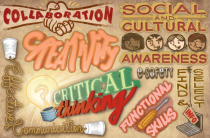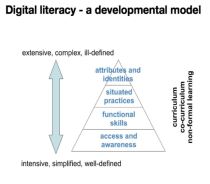I was prompted to really think about the term ‘digital literacy’ after the ocTEL webinar this week when HelenB made the specific point about how it was different from technical competence. Firstly, this was a relief for me as I am far from technically competent. However, I hadn’t previously considered the significance of the actual words so I am grateful to Helen for highlighting this to me with her likening it to a language. Whereas before I would have thought it was more to do with fads in common parlance this has now helped me that how we use technologies will be as diverse as how we use language – to: write / read / sing / connect etc. and that this will also change for each individual with time and context. Which takes me back to an earlier posting: JISC understands Digital Literacy to “define those capabilities which fit an individual for living, learning and working in a digital society”
In this vein of ‘helping me see’ I thought I would collect together the infographics on digital literacy; I looked for a collective noun beginning with ‘i’ for this but couldn’t find one, so here are the bevy of infographic beauties:
First up is from the Rheingold video (21st Century Literacies) that is recommended in the course notes this week:
Attention and other 21st Century Literacies (also at http://www.educause.edu/ero/article/attention-and-other-21st-century-social-media-literacies)

- Attention
- Participation
- Collaboration
- Network awareness
- Critical consumption
Next I was directed towards Futurelab thanks to Imogen Bertin’s posting regarding questionnaires ‘Surveys… the nerdy view’. The handbook http://www.futurelab.org.uk/resources/digital-literacy-across-curriculum-handbook is aimed at educational practitioners in schools, provides a rationale to embed technology across the curriculum. There are also supporting case studies as well as these lovelies:
I love the graphic from the front cover but Diagram 1.1 is probably more useful as it demonstrates the inter-relationships. This then prompted me to think about the readiness-questionnaires – we need to consider the relevant importance of each of these to individual learners and their desire to develop each as well as their starting point. Think webinar quote was ‘bundles of attributes’. My results from the 4 surveys were: yes / yes / no / proceed with caution which was confusing until I read ‘Surveys… the nerdy view’ and some of the more cynical views on their purpose in the webinar. The results from the surveys from HelenB’s forum question ‘An alternative approach’ are much more useful (sliding scale) and come with colour-coded guidance too. Guidance that encourages the learner to think about their results and as a prompt for taking responsibility for their learning. I hope to do a separate post on the role of self-motivation in developing fluency.
These are from the webinar yesterday too:
Finally:http://dougbelshaw.com/blog/2012/03/23/my-tedx-talk-on-the-essential-elements-of-digital-literacies-video/#.T3A9nmGoPiw. Nice to end on a TEDx link too





